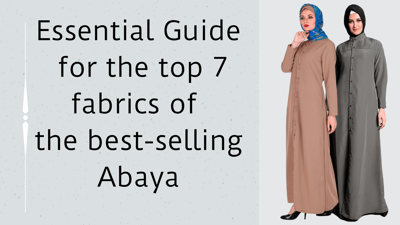The Top 7 fabrics you need to consider while importing wholesale Abayas
The history of abaya
Abaya, a loose over-garment, symbolizes Islamic wear that covers the parts of the body as said in Islam. “O Prophet, tell your wives and your daughters and the women of the believers to bring down over themselves [part] of their outer garments. Chapter (33) sūrat l-aḥzāb.
The flared style of abaya was introduced to the world about 4000 years ago as an Islamic dress for women. With the lapse of time, Abaya has become an essential part of the fashion world and even the red carpet.
It was all about the great efforts of the worldwide Fashion designers who managed to reform public opinions of the abaya look by creating a state of art in sketching different styles of the abaya.
And instead of dedicating the black color to dye the abaya, a wide collection of colors was presented. The emergence of different styles, in countries that abaya is a must-wear, helped people to love the abaya.
Abaya for both genders
Interestingly, a wide piece of garment in a proper length is not only a dress code for women but also men in some Islamic and non-Islamic countries. Accordingly, A man’s nationality can be recognized by the style of the abaya they wear. For example, in Gulf, Men dress in Dishdasha or Kandura which is a white ankle-length abaya with a Sherwal. The overall style is the same, but the names are different.
However, The flared style of abaya isn’t necessarily to be a referent for the Islamic religion, it represents, in some countries, a national dress like India and Afghanistan where men dress a mid-length tunic with a Sherwal, in the same color, underneath.
How to pick the best fabric for Abaya
Regardless of gender, in most countries where people have to don abaya, they are more likely to face high degrees of temperature. For this reason, any shopper needs to pay attention to the type of material used before making any purchase decisions.
There is no room for debate when it comes to choosing a Light and gentle Abaya in the summer, light material helps the body to keep the freshness during the day minimizing the probability of suffering sun allergy particularly if the abaya is dyed in black color.
What are the best fabrics for Abaya?
1) Nidha
It’s one of the good-looking fabrics that women love to dress in because of its medium-weight texture and its different colors that provide a flawless shape. Nidha is made of Polyester material which is characterized by being good at wicking moisture and feeble at drawing the sweat away, the sweat gets trapped in the weaves instead.
2) Chiffon
Chiffon material, with its different degrees of quality, is a light soft material used to manufacture chic abayas with some embellishment for the perfect look. What makes chiffon abaya a good choice for special nights is the material’s transparency that proffers a stunning look for women. However, chiffon abaya is usually produced with attached cotton, or silk, lining underneath to cover the body.
3) Cotton
Cotton, including the blended one, is the best option for both genders when it comes to picking a comfy abaya due to its breathable material that leaves the body cool and dry. In terms of designating abaya, cotton is commonly used in producing sleepwear and loungewear styles.
4) Crepe
There's no way to Shop at a modest clothing hijab boutique without catching the sight of a considerate collection of Crepe abayas. Crepe material is used excessively to sew women’s attire because of the availability of its different colors, in addition to its potential at resisting repetitive wash damage.
5) Satin
Satin reflects intimacy, tenderness, and sophistication. It is a premium soft material that is highly recommended when it comes to purchasing elegant outfits for very special evenings. So if you are an abaya lover, it’s essential to have at least one chic satin abaya in your wardrobe to be ready at any time.
6) Jersey
Jersey is a breathable soft fabric with stretchy weaves which make it more likely to expand according to the body shape. How the jersey gets produced is the reason behind its being a popular fabric in sewing abaya and many other types of the garment; as manufacturers kept modifying the texture of jersey using a mixture of cotton and synthetic fabrics until it becomes a little bit cheaper and more durable.
7) Georgette
Finally, you need to consider the softest and most smooth fabrics. However, manufacturers keep modifying the materials by blending natural and synthetic fabrics to get high-quality weaves with lots of advantages. So having a different collection of abayas is recommended because of the fabric's different characteristics that include both: Pros and cons.




